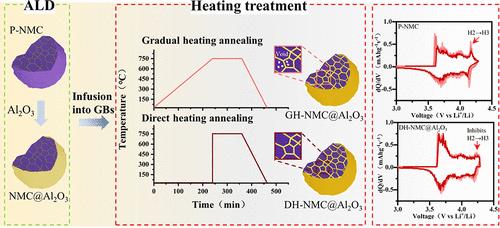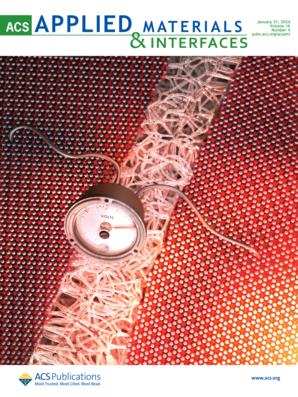Optimizing Annealing Strategy to Achieve Effective Grain Boundary Modification with Aluminum Oxide for Stable Cycling Ni-Rich Cathodes
IF 8.2
2区 材料科学
Q1 MATERIALS SCIENCE, MULTIDISCIPLINARY
引用次数: 0
Abstract
Grain boundary engineering, achieved by combining annealing and surface coating, is an effective strategy for modifying high-nickel-layered oxide cathode materials. However, high-temperature annealing can induce irreversible phase transformations in high-nickel materials, which significantly hinder lithiation/delithiation and degrade their electrochemical performance. In this study, we propose a grain boundary engineering approach for LiNi0.83Mn0.05Co0.12O2, combining rapid heating to the annealing temperature with atomic layer deposition (ALD) to enhance its electrochemical properties. Compared to conventional heating, the rapid heating process minimizes Li/O loss and prevents the formation of a disordered phase. More importantly, grain boundary modification and bulk gradient doping effectively reduce large cracks and the erosion of the cathode, which slows down the capacity decay during long cycles. The direct heating sample exhibits a significant improvement in capacity retention, and after stable cycling for 300 times at C/3, the capacity retention rate remained at 84.7%. This approach offers a promising low-cost strategy for the development of advanced cathode materials with enhanced cycling stability.

优化退火策略实现稳定循环富镍阴极的有效晶界改性
晶界工程是采用退火和表面涂层相结合的方法对高镍层状氧化物正极材料进行改性的有效策略。然而,高温退火会导致高镍材料发生不可逆相变,从而严重阻碍锂化/去硫化并降低其电化学性能。在本研究中,我们提出了lini0.83 mn0.05 co0.120 o2的晶界工程方法,将快速加热到退火温度与原子层沉积(ALD)相结合,以提高其电化学性能。与传统加热相比,快速加热过程最大限度地减少了Li/O损失,防止了无序相的形成。更重要的是,晶界改性和体梯度掺杂有效地减少了阴极的大裂纹和侵蚀,从而减缓了长周期的容量衰减。直接加热样品的容量保持率显著提高,在C/3条件下稳定循环300次后,容量保持率保持在84.7%。这种方法为开发具有增强循环稳定性的先进阴极材料提供了一种有前途的低成本策略。
本文章由计算机程序翻译,如有差异,请以英文原文为准。
求助全文
约1分钟内获得全文
求助全文
来源期刊

ACS Applied Materials & Interfaces
工程技术-材料科学:综合
CiteScore
16.00
自引率
6.30%
发文量
4978
审稿时长
1.8 months
期刊介绍:
ACS Applied Materials & Interfaces is a leading interdisciplinary journal that brings together chemists, engineers, physicists, and biologists to explore the development and utilization of newly-discovered materials and interfacial processes for specific applications. Our journal has experienced remarkable growth since its establishment in 2009, both in terms of the number of articles published and the impact of the research showcased. We are proud to foster a truly global community, with the majority of published articles originating from outside the United States, reflecting the rapid growth of applied research worldwide.
 求助内容:
求助内容: 应助结果提醒方式:
应助结果提醒方式:


